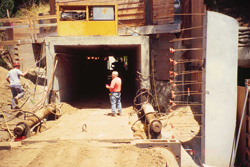
Berkeley Engineering Co., INC.PO Box 7069 General Engineering Contractor
Intranet
|
JackingJacking is a general term used to described a class of tunneling where the tunnel lining is pushed
through the ground using hydraulic rams. This technique has many benefits when employed in the proper conditions,
allowing tunneling to be performed safely, with very little ground settlement, and in conditions with limited Box JackingBox Jacking is an innovative approach to provide for large conduits where trenchless technologies are desired. They can be of any size but are most often found when the conduit size is larger than 10' diameter pipe. The process typically consists of first constructing a backstop that can be pushed against by the jacks. Click for more on box jacking. Pipe JackingPipe Jacking is a very similar process to box jacking only precast concrete or steel pipe is used in lieu of the reinforced concrete box. This technique is widely used for short crossings for pipelines when interruption to highways or railroads is not allowed. A jacking pit is built and a jacking frame is lowered into the pit. |
 ground
cover. The technique began to be used in the United States in the 1970's begining with operations where small diameter
pipes were jacked through the ground. The size of the structures that are jacked have changed over the years and it is
no longer limited to relatively small diameter pipe but now is used with large diameter pipes and box culverts.
Berkeley Engineering has jacked pipes and boxes up and down the state of California. Most recently we jacked a 14'
wide x 11' x 136' long concrete box culvert beneath an active expressway in Northern California.
ground
cover. The technique began to be used in the United States in the 1970's begining with operations where small diameter
pipes were jacked through the ground. The size of the structures that are jacked have changed over the years and it is
no longer limited to relatively small diameter pipe but now is used with large diameter pipes and box culverts.
Berkeley Engineering has jacked pipes and boxes up and down the state of California. Most recently we jacked a 14'
wide x 11' x 136' long concrete box culvert beneath an active expressway in Northern California.